Millions of Muslims around the world embark on the pilgrimage of Hajj to the holy city of Mecca once a year to express their submission to Allah and cleanse their souls.
This sacred site covers an area of 463 square meters and is located in the desert valley of western Saudi Arabia, believed to be the birthplace of the Prophet Muhammad. Many Muslims believe that this stone possesses supernatural powers.
The Sacred Stone “Absorbing the Sins of Humanity”
The holy city of Mecca currently has over 1.2 million residents and is home to many magnificent and ancient mosques. The Hajj pilgrimage is one of the largest events for Muslims and is considered one of the five pillars of Islam.
During Hajj, Muslim pilgrims must perform a series of rituals, such as walking counterclockwise seven times around the Kaaba in the courtyard of the Masjid al-Haram mosque, running back and forth between the hills of Al-Safa and Al-Marwah, drinking water from the Zamzam well, and heading to the plains near Mount Arafat to spend the night in prayer and participate in the “stoning of the devil” ritual. All Muslims aspire to experience this sacred ceremony at least once in their lifetime. For them, the pilgrimage is the pinnacle of their spiritual journey.
The Hajj is an event that demonstrates the unity of Muslims as well as their submission to Allah. Some view the Hajj as a religious obligation that must be fulfilled, and therefore, they risk dangers to perform this ritual. Many even save money for decades just to participate in the pilgrimage.
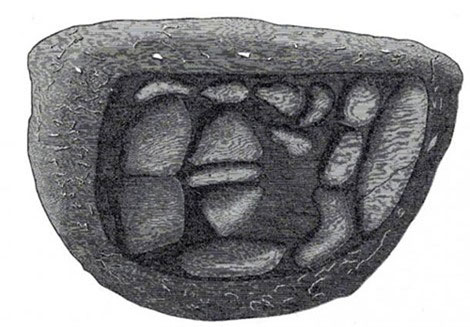
Black Stone facing forward.
According to ABC News, another reason millions of Muslims flock to the holy city of Mecca each year is their belief that participating in the Hajj pilgrimage will help their souls be reborn. The Quran states that on the Day of Judgment, God will weigh the evil and good deeds of a person to decide whether to send them to heaven or hell. Therefore, the Hajj is seen as an opportunity to cleanse past sins. This year, approximately 2 million Muslims from various countries around the world traveled to Saudi Arabia for the pilgrimage.
Last week, a stampede occurred in Mina, about 5 kilometers from the holy city of Mecca, during the “stoning of the devil” ritual. Pilgrims rushed to throw stones at three pillars, symbolizing the act of rejecting evil.
On their pilgrimage to the holy city of Mecca, millions of Muslims must visit the Kaaba mosque. This is the oldest mosque on Earth, believed to have been used by pagans before the advent of Islam. In one corner of the Kaaba mosque, the Black Stone is said to be the birthplace of the Prophet Muhammad. Muslims believe that Allah commanded the construction of the Kaaba, and the Prophet Muhammad placed the stone in the wall of the Kaaba in 605.
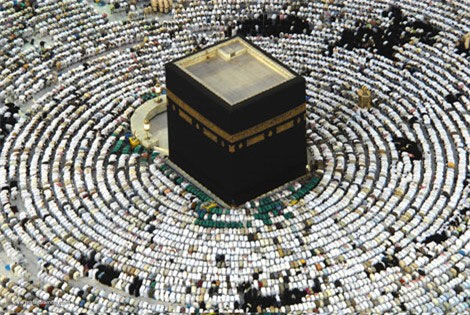
Muslims performing rituals around the Kaaba.
The Kaaba is a rectangular structure made of granite, standing 15.2 meters tall, 10.7 meters wide, and 12.2 meters long, covered with a black silk kiswah embroidered with gold thread. To the southeast of the Kaaba is a door made of pure gold. Inside, the floor is made of marble and limestone, with three supporting pillars. The sacred Black Stone is located in the southeast corner of the building, 1.5 meters above the ground.
Muslims believe that the Prophet Muhammad once kissed the Black Stone, which fuels their desire to pilgrimage to the Kaaba and kiss the Black Stone at least once in their lifetime. The stone is described as dark black, approximately 0.6 meters long. Its surface is shiny black; according to Islamic belief, the stone was originally white but has turned black due to “absorbing the sins of humanity.” The Kaaba is a rectangular structure made of granite, standing 15.2 meters tall, 10.7 meters wide, and 12.2 meters long, covered with a black silk kiswah embroidered with gold thread. To the southeast of the Kaaba is a door made of pure gold. Inside, the floor is made of marble and limestone, with three supporting pillars. The sacred Black Stone is located in the southeast corner of the building, 1.5 meters above the ground.
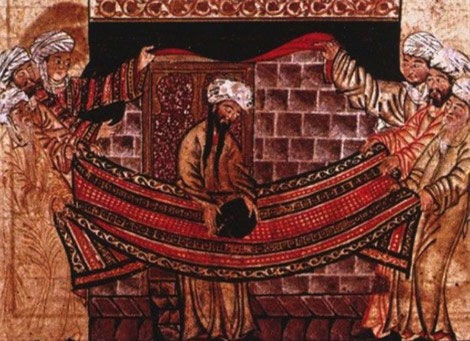
Illustration of the Prophet and elders in Mecca placing the stone in the holy place.
The Black Stone was first described in Western literature in the 19th century. A Swiss traveler named Johann Ludwig Burckhardt visited the Kaaba in 1814 and described the Black Stone in his book about his travels in Arabia published in 1829: “It has an irregular oval shape, with a diameter of about 18 cm, and the surface is rough due to a dozen pebbles of varying sizes cemented together with a small amount of fine cement; the stone appears to have been shattered and then reassembled.”
The Prophet Muhammad referred to the Black Stone as the “right hand of God”, symbolizing loyalty and submission. Some beliefs suggest that the Black Stone will appear on the Day of Judgment, possessing eyes to see and a tongue to speak. Those who kiss the stone do so as a sign of reverence towards Allah. The location of the stone also prohibits people from gossiping or speaking ill… The Black Stone was first described in Western literature in the 19th century. A Swiss traveler named Johann Ludwig Burckhardt visited the Kaaba in 1814 and described the Black Stone in his book about his travels in Arabia published in 1829: “It has an irregular oval shape, with a diameter of about 18 cm, and the surface is rough due to a dozen pebbles of varying sizes cemented together with a small amount of fine cement; the stone appears to have been shattered and then reassembled.”
Muslims also believe that the Black Stone is a part of heavenly stone. There are many legends about it, such as when Adam was expelled from the Garden of Eden, he felt immense guilt. The Black Stone was given to Adam to help him cleanse his sins and allow him to return to paradise. Others believe that the stone was taken from a nearby mountain by the Archangel Gabriel. Over time, the stone has suffered significant damage. During the Umayyad Caliphate’s siege of Mecca in 683, it is believed to have been shattered into many pieces by stone projectiles. In 930, the stone was stolen and taken to Hajar, modern-day Bahrain, only to be returned to Mecca later.
There are many tales of people being killed for attempting to communicate with the stone. In the 11th century, a man was accused of intending to break the stone and was killed on the spot, causing slight damage to the stone. In 1674, someone deliberately smeared dirt on the Black Stone so that “anyone kissing it would be soiled.” Persians were suspected of being involved in this incident and became targets of Muslim curses for centuries afterward. Today, the stone still shows traces of its broken pieces, estimated to be between 7 to 15 fragments. They are held together by a silver frame, secured with silver nails to attach tightly to the stone.
What is the Composition of the Black Stone?
Due to restrictions on direct research of the stone, scientists can only speculate about its composition. They hypothesize that it is a basalt rock, agate, or even a cosmic glass. One theory suggests that the stone is a meteorite worshipped by pre-Islamic Arabs. Anthony Hampton and geologists at the University of Oxford in the UK collected sand samples near the stone and conducted tests.
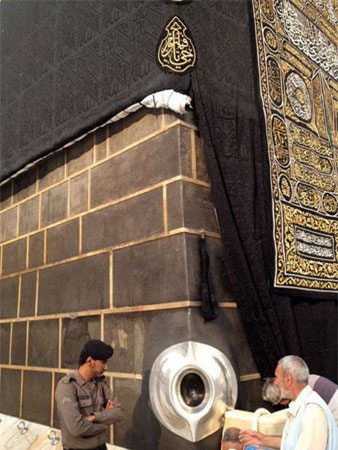
The Black Stone wrapped in a silver frame.
“The stone is covered in mist, as its guardians do not allow any scientific testing to be conducted on it for cultural and religious reasons. Therefore, many efforts have been made to gather information about it. Local sand samples taken from a 2 km radius of the stone show an amount of iridium—a metal commonly found in meteorites that fall to Earth—higher than the normal average in the Earth’s crust.
Additionally, there are many shattered cone cells—a rare geological feature that only forms in the bedrock of impact craters when a meteorite collides with the ground or from underground nuclear explosions.” However, another study conducted by Robert S. Dietz and John McHone at the University of Illinois in 1975 concluded that the Black Stone is neither a meteorite nor contains any supernatural powers.
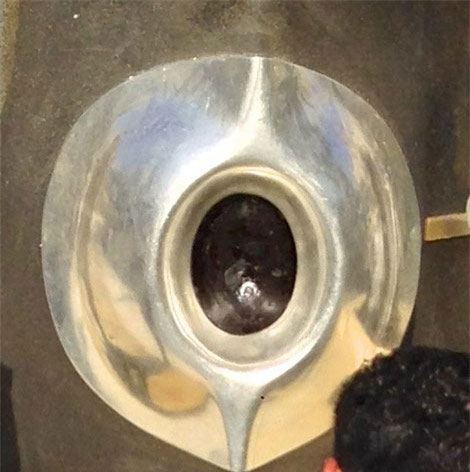
Close-up of the Black Stone.
An anonymous Arab geologist who performed the Hajj examined the stone and discovered a diffuse light band indicating that it is indeed agate.
Elsebeth Thomsen from the University of Copenhagen, Denmark, proposed another hypothesis in 1980. She suggested that the stone could be a piece of glass formed from the impact of a fragmented meteorite that fell at Wabar, a site in the Rub’ al Khali desert located 1,100 km east of Mecca. The craters at Wabar highlight the presence of silica glass blocks melted by the heat of the impacts and infused with particles from a nickel-iron alloy found in meteorites (most of which have been destroyed due to impacts).
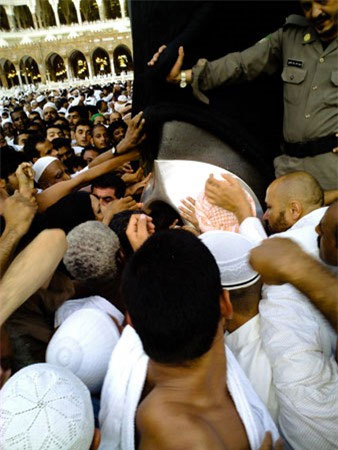
Pilgrims eager to kiss the stone; if unable to kiss it, they use their hands to reach out.
Some pieces of glass are made from shiny black glass with white or yellow holes, filled with gas, allowing them to float on water. Although scientists were unaware of the craters at Wabar until 1932, these craters near Oman were discovered by desert inhabitants. The larger craters have been mentioned in ancient Arabic poetry.
Wabar or Ubar (also known as “Iram of Pillars”) is the location of a beautiful ancient city, which was burned down due to the wrath of its ruling king. If the age of the crater is accurately estimated, it dates back to the time when humans inhabited the Arabian Peninsula. The theory that the stone is a meteorite is viewed with skepticism by geologists. The British Museum of Natural History suggests that it could be a pseudometeorite (a terrestrial rock mistakenly believed to be of meteoric origin). Regardless of its true nature, the Black Stone remains the most famous sacred stone in the world, continuing to be the focal point of pilgrimages to the holy land of Mecca.




















































